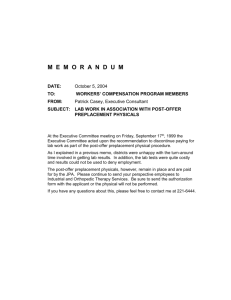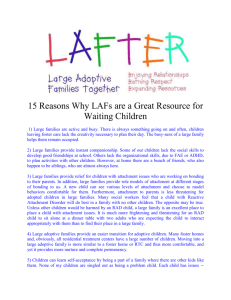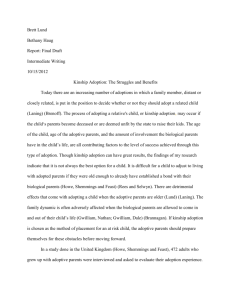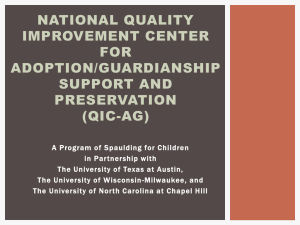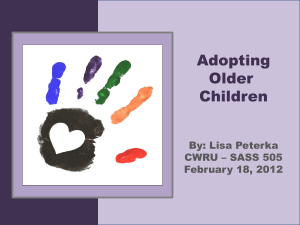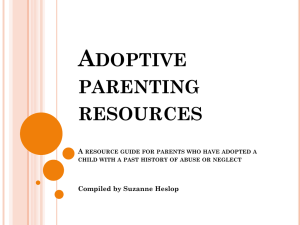Adoption Committee Review Selection
advertisement
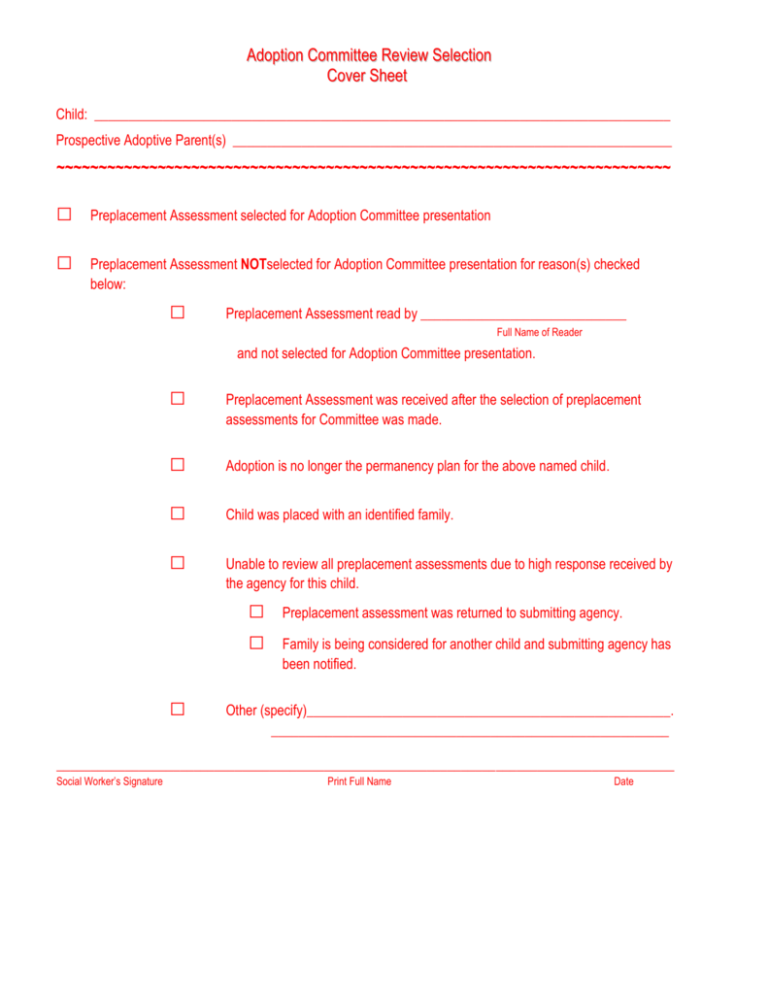
Adoption Committee Review Selection Cover Sheet Child: ____________________________________________________________________________________ Prospective Adoptive Parent(s) ________________________________________________________________ ~~~~~~~~~~~~~~~~~~~~~~~~~~~~~~~~~~~~~~~~~~~~~~~~~~~~~~~~~~~~~~~~~~~~~~~~~ □ □ Preplacement Assessment selected for Adoption Committee presentation Preplacement Assessment NOTselected for Adoption Committee presentation for reason(s) checked below: □ Preplacement Assessment read by ______________________________ Full Name of Reader and not selected for Adoption Committee presentation. □ Preplacement Assessment was received after the selection of preplacement assessments for Committee was made. □ Adoption is no longer the permanency plan for the above named child. □ Child was placed with an identified family. □ Unable to review all preplacement assessments due to high response received by the agency for this child. □ □ □ Preplacement assessment was returned to submitting agency. Family is being considered for another child and submitting agency has been notified. Other (specify)_____________________________________________________. __________________________________________________________ __________________________________________________________________________________________ Social Worker’s Signature Print Full Name Date ADOPTIVE FAMILY SELECTION SCALE (Instructions and Scale) This Scale has been devised as an aid in placement of special needs children, although it can be adapted for infant placements as well. It is designed to help agencies assess prospective adoptive families in relation to the needs of a specific child or siblings group. Ideally, this is a two-part process in which the child's strengths and needs are determined and the family is selected in response to the child's characteristics. The Scale is not a test which will yield the mythical "prefect adoptive family". It is merely a basis for a more objective comparison. This tool can assist the agency in determining that: 1. They have adequate information about the needs of the child to be placed. 2. They have received or gathered sufficient information about the prospective families. 3. They are not overlooking important factors in the matching process. 4. They are using a uniform, child-focused, non-judgmental framework in which to share their concerns about each family. Matching the needs of children to the strengths of available families is a difficult task. It requires a high level of skill and judgment on the part of the child's worker and committee. The Selection Scale is intended to clarify that decision-making process, not to short-circuit ft. Although the pluses and minuses used in this instrument can be tallied, it is intentional that there is no numerical scour as a final product. The questions themselves have varying "weights' which change each time they are applied to the needs of a specific child. Therefore, the appropriateness of a family for a child is measured not by the total number of pluses and minuses, but by looking at the items in which these positive and negative ratings occur. As agencies began to use this tool, other applications became apparent. The Adoptive Family Selection Scale can be used as a guide to writing more complete and focused family studies. Whether an agency uses studies written by the adoptive family, the worker or some combination of these, the Scale may suggest revisions or additions to the current format. The instrument may be shared with the family to help them understand the basis for their selection. With the consent of the family, the Scale could be used as a reference point in initial therapy sessions to look at the interaction of strengths and needs between child and family. At the administrative level, the Scale can also be used as a training tool to help workers become more proficient at accurately assessing a family's adoptive potential. We encourage agencies to adapt this instrument to meet their own needs. Before the Adoption Committee Meets The worker who has the most thorough knowledge of the child should prepare a comprehensive Child PreAdoptive Summary on the child. This worker then completes the Child Profile, in order to pinpoint critical placement factors. The child's summary, the Profile, the families' studies to be reviewed and several blank Family Scale forms are distributed to each committee member. The worker also reserves an extra copy of the Family Scale to record the group's deliberations at the meeting. 1 of 4 Each committee member reads the child's summary and Profile, then reviews the collection of families' studies and completes a Scale for each one. This is done by circling + if the item listed would be of benefit to the child and - if it would be detrimental. If a factor does not appear to be clearly positive or negative of if it does not apply to this particular situation, circle NINA (neutral or not applicable). If the home-study fails to address one or more of the factors listed, place an asterisk in the comments section. Request that the worker obtain the needed information from the family’s county or state. Note questions or issues for discussion in the comments section. Use additional space on the back if necessary. At the Adoption Committee Meeting Members bring the Child Profile and their completed Scale on each family to the meeting. The chairperson polls the members regarding their answers on each item. A flip-chart or a board could be used to note items that have produced a wide divergence of opinion or that members feel merit additional discussion. As resolution is occurring, the group’s secretary completes the extra copy of the Adoptive Family Selection Scale reflecting the judgment of the committed. If there are items on which consensus is not reached, those are noted on the form under comments. During the discussion, the focus should remain on the needs of the child as highlighted in the Profile. After the Adoption Committee Meeting In order to document the agency’s choice of family, the composite Scale for the family selected may be filed in the child’s record. Composite Scales on the families may be retained if the agency requires additional documentation to support their choice. Individual Scales completed by committee members should be destroyed. Alternative Method A variation of this process may b e more practical in some agencies. As described previously, the child’s worker prepares the Child Pre-Adoptive Summary and Profile and the committee members receive it along with the families’ studies to be read. In this variation, only the child’s worker completes a Scale on each family. At the committee meeting, the worker presents his/her findings regarding the best match of child and family. The Scale is used to explain the choice and engender further discussion, after which a group decision is reached. 2 of 4 3 of 4 Family Name: ______________________________________ Residence County or State: _____________________________ Child(ren) being considered for: ____________________________________________________________________________ Completed by: _________________________________________________________________________ Date: ___________ After reading the comprehensive Child Pre-Adoptive Summary, Profile and the Preplacement Assessment complete the Adoptive Family Selective Scale for each family. Check “+”, if the item listed would be of benefit to the child and “-“, if the listed item would be detrimental to the child. If an item does not appear to be clearly positive or negative or if it does not apply to a particular situation, check “N/NA” (neutral or not applicable). If the Preplacement Assessment fails to address one or more of the factors listed, place an asterisk in the Comments sections. Note questions or issues in the Comments section. + A. 1. 2. 3. 4. 5. B. 1. 2. 3. 4. 5. 6. 7. 8. GENERAL FACTORS Thoroughness of Preplacement Assessment Post placement supervision Resource availability Location Other factors (list and be specific) FAMILY SPECIFICS FACTORS Adoption preparation/training Parenting experience Experience with foster parenting Experience with adoption Other experience with children Knowledge of separation issues Knowledge of developmental stages Commitment to adoption as expressed by adoptive family 9. Relationship with agency 10. Life stability (marital, employment, residential) 11. Age of prospective adoptive mother/father 12. Health of prospective adoptive mother/father 13. Quality of family life (communication, harmony, comfort with roles). 14. Approximate mix of structure and flexibility 15. Style of discipline 16. Family appropriately enmeshed/disengaged 17. Finance (income/ assets) 18. Money management skills 19. Physical facilities of the home 20. Comments of references 21. Personal support systems (church, neighborhood, community, etc. 22. Extended family support s 23. Ability to use community resources 24. Child care plan 25. Personal background of prospective adoptive mother 26. Prospective adoptive mother’s resolution to past conflicts 27 Personal background of prospective adoptive father 28. Prospective adoptive father’s resolution to past conflicts 29. Lost of a child and resolution 30. Reason for seeking adoption 31. Other (list and be specific) C. RELATIONSHIP FACTORS 1. Is this the child the family asked for? - N/NA COMMENTS + (a) Age (b) Race/ethnicity (c) Gender (d) Sibling group 2. Is the family prepared to deal with this child’s special needs? (a) Health, handicapping conditions (b) Biological family issues (c) Foster care history (d) Effects of neglect (e) Effects of physical/sexual abuse (f) Intellectual/.educational needs 3. Is this family’s lifestyle compatible with the child’s need? (a) Family’s interests/activities (b) Family culture (c) Family’s religion (d) Family’s emotional characteristics 4. Is the structure of this family compatible with the child’s needs? (a) Family composition (couple or single parent) (b) Number of children in the family (c) Ages of children in the family (d) Position of in family that adopted child would occupy (eldest, only, etc.) 5. Is the other child(ren) in the home compatible with this child needs? (a) Level of current emotional/behavioral functioning (b) Preparation for gains and losses inherent in adding a sibling (c) Ability to deal with a child who may have significant behavioral and intellectual differences 6. Does the family have a previous relationship with this child? (a) Extended family (b) Current caretakers (c) Previous caretakers (d) Others (teachers, neighbors, etc.) 7. Is the family open to contact with significant people from child’s past? (a) Biological parents (b) Siblings (c) Extended family (d) Previous caretakers (e) Others 4 of 4 - N/NA COMMENTS CHILD PROFILE Child’s Name: _______________________________ Date of Birth__/__/____ Sex:: _____ Race: __________ Sibling Inforamtion:___________________________________________________________________________ Adoption Assistance Information: □ Cash Payment □ Vendor Payment □ Non Recurring Adoption Expenses □ Children’s Special Health Services □ Medicaid □ HIV+ Supplement □ Special Children Adoption Incentive Fund □ Other (specify)_____________________________________ Strengths Needs Desirable Characteristics/Qualities of Prospective Adoptive Family Comments (Use additional space, if necessary)

